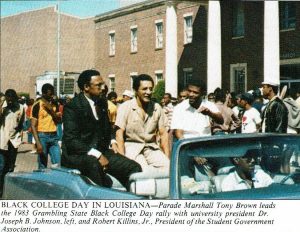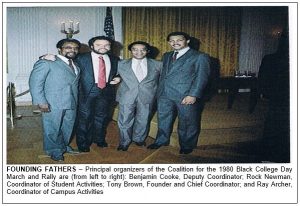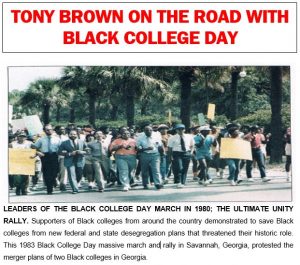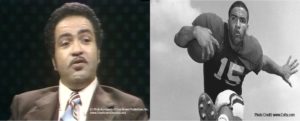 Doug Williams was the first Black quarterback to win a Super Bowl, but before Doug Williams there was Sandy Stephens. Stephens, a second-round pick in the 1962 draft had the opportunity to play in the NFL – just not as a quarterback. “Sandy Stephens was a pioneer,” Tony Dungy said. “Sandy quarterbacked at a time when it was unusual. He was the first African-American quarterback to lead a team to a National Championship. And he did that at Minnesota.” (“Sandy Stephens Paved Path For Quarterbacks of Today,” Heather Lloyd, 2/22/2018, Colts.com/ColtsRoundup)
Doug Williams was the first Black quarterback to win a Super Bowl, but before Doug Williams there was Sandy Stephens. Stephens, a second-round pick in the 1962 draft had the opportunity to play in the NFL – just not as a quarterback. “Sandy Stephens was a pioneer,” Tony Dungy said. “Sandy quarterbacked at a time when it was unusual. He was the first African-American quarterback to lead a team to a National Championship. And he did that at Minnesota.” (“Sandy Stephens Paved Path For Quarterbacks of Today,” Heather Lloyd, 2/22/2018, Colts.com/ColtsRoundup)
In 1960, despite a racist society, University of Minnesota football Coach Murray Warmath, a mild-mannered White Mississippian, gave a talented young Black man from Uniontown, Pennsylvania a chance. That’s all Sandy Stephens ever wanted. A chance to stretch out and give football fans what they liked most – a good game and a winning team. As unlikely as Coach Warmath’s background would suggest, he would teach America a lesson in racial tolerance.
“A quarterback is normally an extension of the coach, that’s the ideal situation. A coach wants a quarterback to be an extension of his personality. I think that is one of the things that has kept Blacks from being quarterbacks,” said Martin Wyatt in a 1979 Tony Brown’s Journal TV interview. (Martin Wyatt, Tony Brown’s Journal #211 – “Gold Is Also Black”)
In football, the team leader is the quarterback. One coach said there are two essentials in football – a defender and a quarterback. A quarterback must excel under fire, if a team is to win. Stephens was the first Black to play quarterback at the University of Minnesota and remains the only quarterback to take the Gophers to the Rose Bowl (1961 and 1962). “There goes the four-star general,” they used to say at the University of Minnesota when the all-American, most valuable player in The Big 10 and academic scholar, Sandy Stephens went by. Fifty-three other colleges had wanted him, eight in The Big 10. Major league baseball also chased Stephens.
This 1979 Tony Brown’s Journal interview (TBJ #211 – “Gold Is Also Black”) Martin Wyatt, shared his remembrances of Stephens: “Sandy Stephens was the first quarterback to stand up and say to the National Football League, ‘Only draft me as a quarterback. I won’t let you change me. If you are going to draft me, then draft me as a quarterback.’ No NFL team gave him an opportunity, so he went to Canada to play for The Canadian Football League Montreal Alouettes.”
“At that time, to African Americans who aspired to play quarterback, that point of view didn’t make sense. And the public was not going to allow that to happen on that level of the NFL,” said former Indianapolis Colts coach Gene Huey. (“Sandy Stephens Paved Path For Quarterbacks of Today,” Heather Lloyd, 2/22/2018, Colts.com/ColtsRoundup)
Stephens did go on to play quarterback in the Canadian Football League and his story inspired many others along the way, including Hall of Fame head coach Tony Dungy.
The first Black golden boy of American football may not have made it to the Football Hall of Fame, but he made mine and a lot of others when on the field he showed us how to run to daylight when opportunity presents itself.
“Don’t wait for a fumble, jar the ball loose and when you’re asked to be your own worst enemy, read the defense and call a play that’s unexpected.”
This is my final goodbye to my friend. May he rest in peace. -- Tony Brown
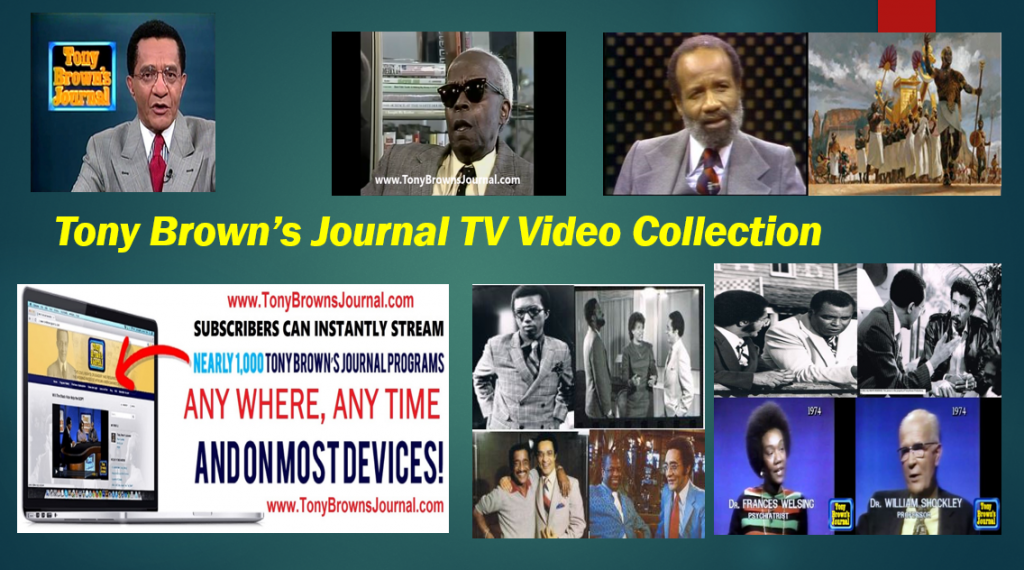
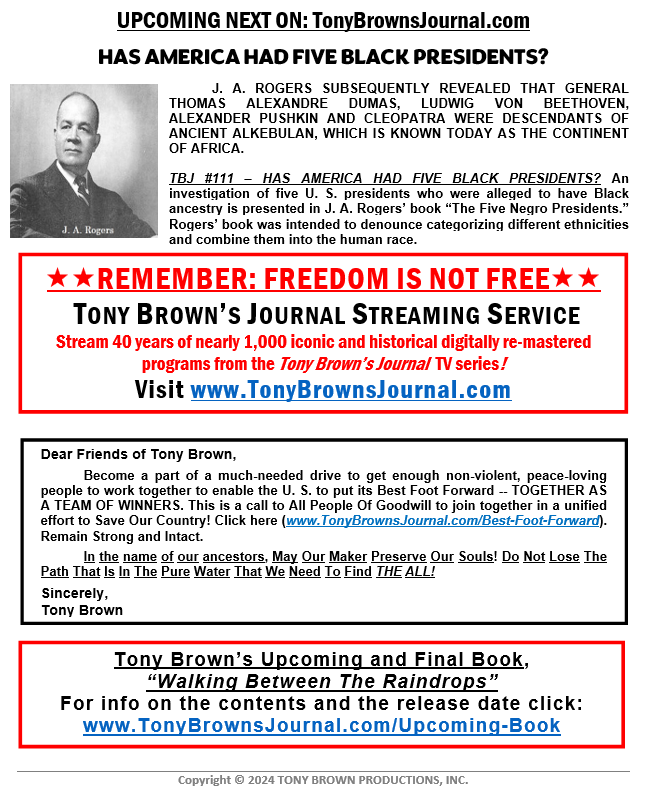 UPCOMING PROGRAMS ON TonyBrownsJournal.com:
UPCOMING PROGRAMS ON TonyBrownsJournal.com:
TBJ #2515: “Benjamin Banneker: Truth to Power:” Imagine being Black in the 1700s and becoming a self-taught surveyor who was pivotal in planning the layout of our nation’s capital and inventing a clock in 1753. In 1791 alone, Benjamin Banneker completed the survey of Washington, DC, published his first almanac and confronted one of the nation’s founders, Thomas Jefferson, and his doctrine of Black inferiority.
TBJ #2201 – “In The Words of Frederick Douglass”: In the 1960s, Rev. Martin Luther King, Jr. was the premier spokesman for the Black community, articulating the struggle for freedom and equality. Rev. King carried on the tradition of another stirring voice for Black progress, Frederick Douglass. This edition relives the Black struggle to achieve the American dream in pictures and dramatic reenactments.
TBJ #923 – “Tear on the face of America”: The Fourth of July Celebration is a reminder of the greatness and beauty of the concept of freedom and hope. The Statue of Liberty, a symbol of hope, is an ancient symbol that was inspired by the Great Pyramids of Egypt in Africa. But She didn’t welcome my Black/African ancestors; they came before She did, in horrible slave ships to build the roads and the bridges. African Blacks guaranteed the progress of the 12 million European immigrants made who came through freedom’s door at Ellis Island, New York.
TBJ #605 -- America’s Black Eagles – Part 1: Clipped Wings: Can Blacks fly airplanes and fight? The answer to this odious question would come from creating the only all-Black Air Force ever established by the U.S. military. This segment reviews this dark period in racial relations and the Black community's response to a segregated "separate but equal" policy of the Army Air Corps in WWII.
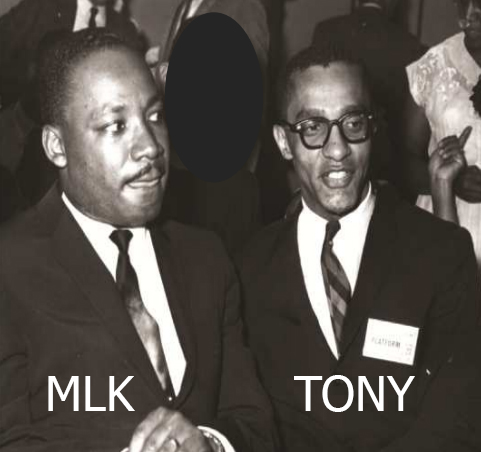 HISTORICALLY, TONY BROWN IS also …
HISTORICALLY, TONY BROWN IS also …
- Coordinator of the “Walk To Freedom with Martin Luther King, Jr.” in Detroit (1963), according to the July 29, 1963 edition of Business Week magazine, “the largest civil rights march in history.”
- WINNER of the prestigious Silver Circle Award from the National Academy of Television Arts & Sciences
- Dean Emeritus and Professor, Scripps Howard School of Journalism and Communications, Hampton University
- First and Founding Dean and Professor, School of Communications, Howard University
- Founder, BLACK COLLEGE DAY, 1980
- 2015-2016 National Association of Black Journalists Hall of Fame Inductee
- Black Emmy Nominee – 1989 Special Recognition Award Winner
- Distinguished Visiting Professor, Honorary Degree – American University, Paris, France
- Distinguished Visiting Professor, Central Washington University, Ellensburg, WA
- Talker’s, Radio Trade Magazine: Selected as “One Of The 100 Most Important Radio Talk Show Hosts In America”
- “Tony Brown Chicago,” WLS-AM Radio (Chicago)
- “Tony Brown,” WLIB-AM Radio (New York) “Tony Brown at Daybreak,” WRC-TV (Washington, DC)
- “Tony Brown’s Journal”/“Black Journal” (TV series: 1968-2008): “The Most Complete and Thoughtful Record of African-American Opinion.”
- U. S. Army 272 field artillery (s-1 Intelligence) battalion and cadre (1953-1955). Neu-Ülm, GERMANY. Honorable discharge.
BLACK HISTORY
- Great Events In African-American History
- Tony Brown Donates $100,000 to Hampton University Scholarship Fund and sows the seeds of success for future journalists www.TonyBrownsJournal.com/blog/Tony-Brown-Donates-100k
- Tony Brown with Hampton University Journalism Students Make History At The New York Times Harvard, Columbia, Syracuse Place Second In Competition www.TonyBrownsJournal.com/blog/Tony-Brown-With-HU-Makes-history
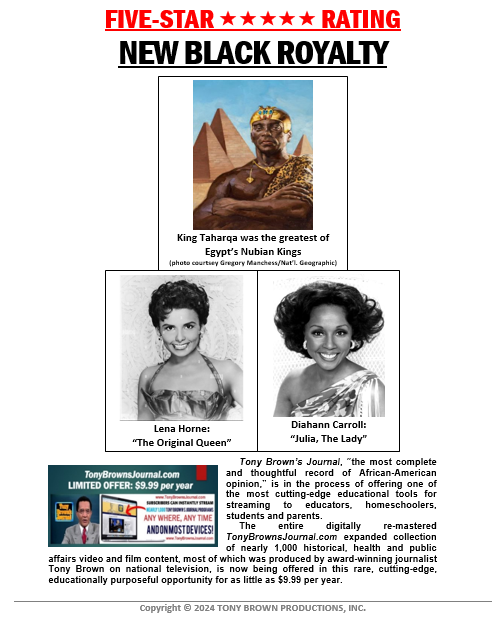
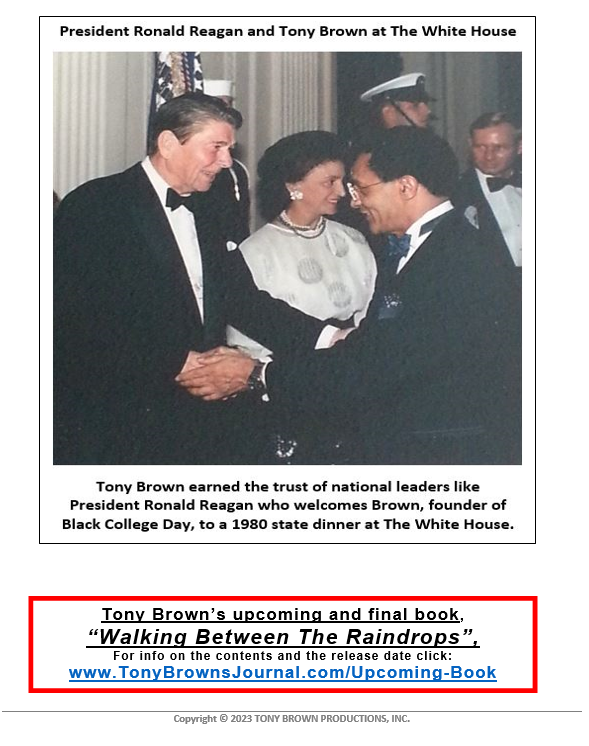 HAS THE BLACK LEADERSHIP BETRAYED ITS OWN COMMUNITY?
HAS THE BLACK LEADERSHIP BETRAYED ITS OWN COMMUNITY?
WE STOOD WITH MARTIN LUTHER KING, JR.
“I was there 50 years ago, in 1963, one of the last two Directors left standing, where 500,000 marchers once stood.” --Tony Brown
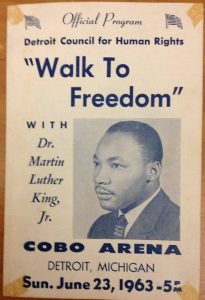 “LARGEST CIVIL RIGHTS MARCH IN HISTORY”
“LARGEST CIVIL RIGHTS MARCH IN HISTORY”
The following week, in its July 29, 1963 edition, Business Week magazine called the Detroit event the “largest civil rights march in history.” Subsequently, an official police source, in an affidavit, confirmed attendance of “no fewer than 250,000 and as many as 500,000 people.” Black people came mostly from throughout the nearby Midwest region.
More official confirmation has been forthcoming since then. Nearly 40 years later, in 2003, The Wall Street Journal would report on page one that the famed King Dream Speech may have had its roots -- not at the March on Washington (which drew 250,000), on August 28, 1963, but elsewhere, perhaps 66 days before in Detroit, Michigan where the attendance may have reached, according to an official police affidavit, 500,000 people.
Although I had no official role in the Washington March, I did witness it as a Detroit correspondent for the national Pittsburgh Courier newspaper chain of African-American local publications throughout the United States, an affiliate of the Black Press, from the steps of the Lincoln Memorial within a few feet of Dr. King and I was included in Life magazine’s limited photo coverage of this historic event.
All of this in only 66 days! My head was spinning with excitement and wonderment. It seemed that my Detroit decision to choose activism as a way of life had become my destiny.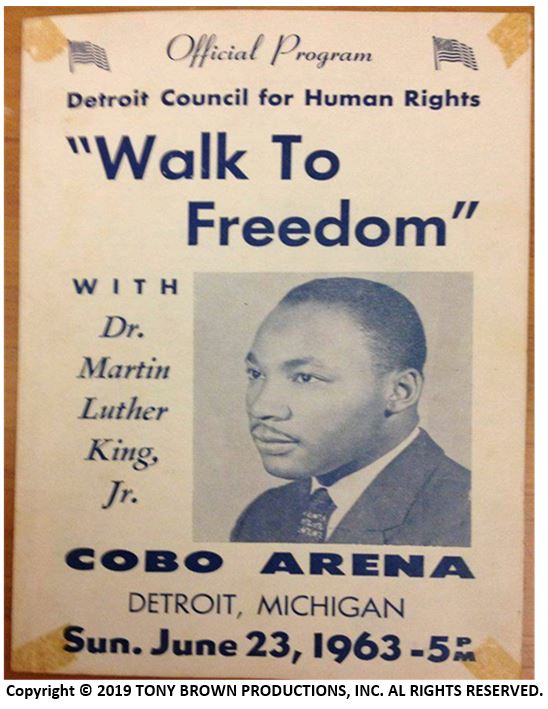
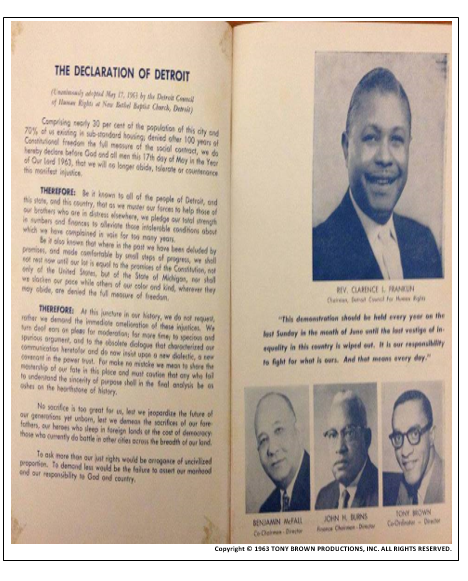
2013 – 50th Anniversary “Walk to Freedom March” – Detroit, MI
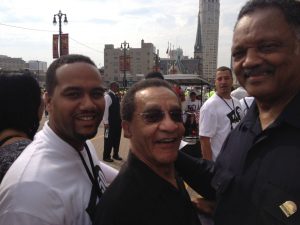
Tony Brown (center) Grand Marshal of the 2nd and final Detroit March on June 22, 2013, drew 200,000, with his grandson Remy Harris (left) and Jesse Jackson (right).
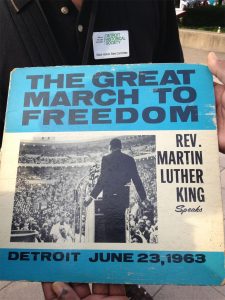
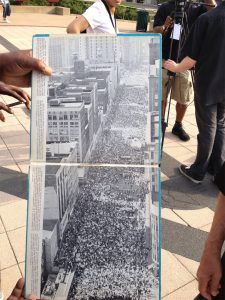
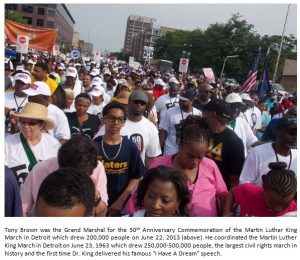

TONY BROWN OFFERS EDUCATORS, STUDENTS, HOMESCHOOLERS AND PARENTS ACCESS TO A NEW VISUAL STREAMING LEARNING TOOL FOR BLACK HISTORY AND CULTURE
Tony Brown’s Journal, “the most complete and thoughtful record of African-American opinion,” is in the process of offering one of the most cutting-edge educational tools for streaming to educators, homeschoolers, students and parents. The entire digitally re-mastered TonyBrownsJournal.com collection of nearly 1,000 historical, health and public affairs video and film content that was produced by award-winning journalist Tony Brown on national television for over 40 years (1968-2008) is now being offered in this rare cutting-edge educationally purposeful opportunity for as little as $9.99 per year.
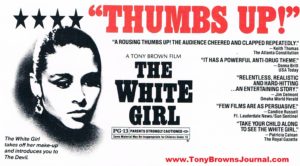
Free streamed copy of “THE WHITE GIRL" movie with each annual subscription is a streamed copy of “The White Girl,” a full-length anti-drug feature movie directed by Tony Brown that was released via commercial syndication in movie theaters in 1995 with a PG-13 rating. The opening inaugural debut of “The White Girl” at the Liberty Theatre in Hamilton, Bermuda (Bahamas) broke the house box-office gross record, according to Hollywood Reporter, a trade magazine.
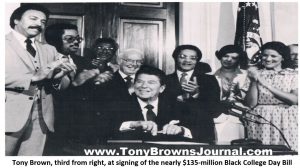 BLACK COLLEGE DAY BILL- White House cabinet members and advocates of equal education look on as President Reagan signs Executive Order 12320, just one year after the first historic Black College Day rally in Washington, DC, that increased the amount of federal funds to these institutions by $9.6 million. From left to right are: Education Secretary Terrell Bell, Tony Brown, Founder and Chief Coordinator of Black College Day, Thelma Duggan, Coordinator of Minority Affairs at the Department of Transportation; and Transportation Secretary Elizabeth Dole.
BLACK COLLEGE DAY BILL- White House cabinet members and advocates of equal education look on as President Reagan signs Executive Order 12320, just one year after the first historic Black College Day rally in Washington, DC, that increased the amount of federal funds to these institutions by $9.6 million. From left to right are: Education Secretary Terrell Bell, Tony Brown, Founder and Chief Coordinator of Black College Day, Thelma Duggan, Coordinator of Minority Affairs at the Department of Transportation; and Transportation Secretary Elizabeth Dole.
LEADERS OF THE BLACK COLLEGE DAY MARCH IN 1980; THE ULTIMATE UNITY RALLY. Supporters of Black colleges from around the country demonstrated to save Black colleges from new federal and state desegregation plans that threatened their historic role. This 1983 Black College Day massive march and rally in Savannah, Georgia, protested the merger plans of two Black colleges in Georgia.
